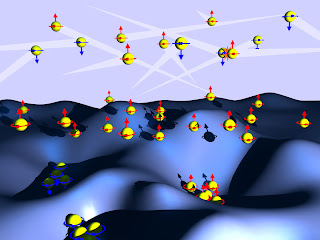Type: Graphic/illustration. Source: National Institute of Standards and Technology. Credit Line as it should appear in print: Credit: J. Fal/JILA. AV Number: 07PHY007, Date Created: February 15, 2007, Date Entered: 2/15/2007
Disorder May Be in Order for ‘Spintronic’ Devices
Physicists at JILA are using ultrashort pulses of laser light to reveal precisely why some electrons, like ballet dancers, hold their spin positions better than others—work that may help improve spintronic devices, which exploit the magnetism or “spin” of electrons in addition to or instead of their charge. One thing spinning electrons like, it turns out, is some disorder.
JILA is a joint venture of the National Institute of Standards and Technology (NIST) and the University of Colorado at Boulder.
Electrons act like tiny bar magnets whose poles can point up or down. So-called “spintronic” circuits that sense changes in electron spin already are used in very high-density data storage devices, and other spin-based devices are under study. Greater exploitation of spintronics will require spins to be stable—in this case meaning that electrons can maintain their spin states for perhaps tens of nanoseconds while also traveling microscale distances through electronic circuits or between devices.
Scientists have suspected for some time that electrons best maintain the same spin direction at a “magic” electron density. New JILA measurements, described in Nature Physics,* suggest where the magic originates, revealing that electrons actually hold their spins for the longest time—three nanoseconds—when confined around defects, or disordered areas, in semiconductors. They lose their spin alignment in just a few hundred picoseconds when flowing through perfect areas of the crystal. This finding explains the role of density: at very low density, electrons are strongly confined to different local environments, whereas at extremely high density, electrons start hitting each other and lose spin control very fast. The magic point of maximum spin memory occurs at the cross-over between these two conditions.
The JILA research is the first to characterize the so-called electronic disorder in semiconductors and connect it to the spin dynamics. Disorder may arise because, when thin films are being made, imperfections consisting of even one extra layer of a few atoms create islands where electrons act as if they were trapped in stationary molecules. The new findings present a design challenge for spintronic devices, because the conditions that best preserve memory are not conducive to optimum transport properties.
The JILA team confined electrons in “quantum wells,” and used a visible laser beam of varying intensity to systematically vary electron density in the wells. For the measurements, infrared laser pulses were applied in pairs. The first pulse excites some electrons and gives them a spin, creating a temporary magnet. The polarization of light from the second pulse, reflected off the quantum wells, is rotated by the electrons. By measuring the magnitude of that rotation, the researchers infer how many electrons have the same spin. Then an external magnetic field is applied and the electrons rotate around the field, flipping their spins up and down as they go, and causing the reflected light’s polarization to oscillate. Based on the oscillation patterns, scientists can infer electron disorder and calculate spin retention times.
The research was supported in part by the National Science Foundation. The quantum wells were provided by the University of Manchester, United Kingdom.
* Z. Chen, S.G. Carter, R. Bratschitsch, P. Dawson and S.T. Cundiff. Effects of disorder on electron spin dynamics in a semiconductor quantum well. Nature Physics. Posted online Feb. 11, 2007. Disorder May Be in Order for ‘Spintronic’ Devices
Technorati tags: Public Domain Clip Art and clip art or public domain and Spintronic’ Devices or National Institute of Standards and Technology and electronic disorder and or Scientists Discover New Way to Study Nanostructures and "I want you" Uncle Sam and Presidential Podcast 08/04/07













No comments:
Post a Comment